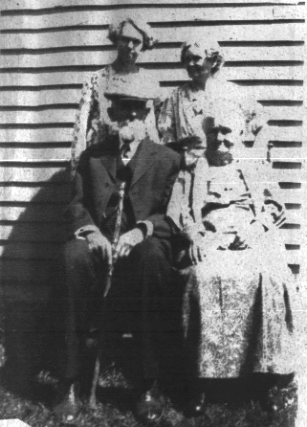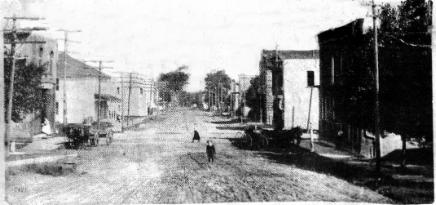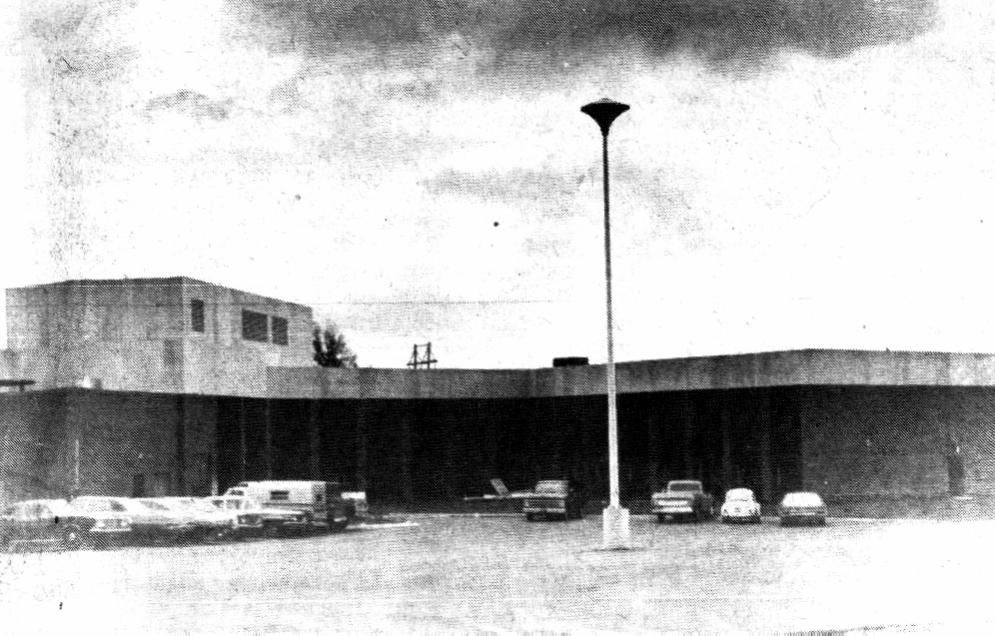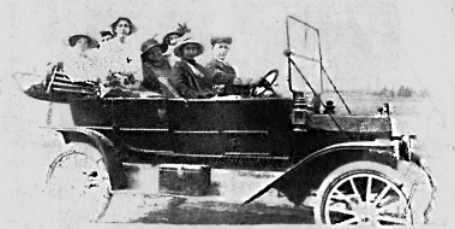| Oconto County Reporter
November 11, 1971 - Special Edition Contributed by Dave Cisler
Oconto Falls – Growing Bigger and better
(The first century of the history of Oconto Falls (1846-1946) as written by Agnes Volk Elver, a granddaughter of the city’s founder, John Volk) John Volk was born in New York City December 22, 1806. When he was three years old, his father died and his mother, with her family of two boys, went to live with her parents on a farm in Scarlenburg, N. J. Her father’s name was John Christie, and his farm, which came to him through his father, was the same upon which Major Andre, the British emissary to the traitor Arnold, was hanged and buried. His wife, Almira Ketchman Volk, was born on Long Island November 18, 1810, on a tract of land then known as Patent, which an English gentleman, Nichols by name, had obtained from the King of England and colonized. Her grandfather had come from England with a group of Nichols’ early colonists. They were married in 1830. About this time, Greeley,
the noted journalist, made his famous call to the young men to “go west
and grow up with the country.” Being of an ambitious nature, the
Volks took the advice. Though their hardships were many, there was
never a regret.
They remained in Chicago for sometime, where Mr. Volk worked at his trade as a cooper. While there, they purchased a plot of land which is now Lincoln Park. In 1842, he sold his Chicago property, purchased a vessel and made his way with his family and belongings to Kewaunee, where he heard there were great possibilities in the lumber business. During their stay in Kewaunee, a son, William, was born - the first white child to be born there. In her autobiography, written in her 85th year, Almira Volk says: “John, seemingly ever alert for something better and hearing about Oconto Falls with its wealth of lumber, sent two men to investigate. Their report was so glowing that he went at once to Green Bay, saw the man who had a claim to the property – which was as yet government land not in market – bought his right and went to Chicago by stage to complete the deal. “In less than two months, we arrived in Oconto Falls - October 1846 – landing on the west side just below the falls. This country at the time was extremely beautiful and picturesque. Tall, stately pines stretching far up to the heavens, stood upon all sides, while the river, clear as crystal and unmolested, gliding along with the utmost complacency, plunged over a rocky abyss and went foaming away below.” Two small shanties, one of logs and the other of bark, served as shelter until something better could be provided. A sawmill was built that winter on the sight where the sulphite mill now stands. They also cleared four or five acres on a bluff overlooking the river on the opposite side from the sawmill preparatory for spring gardening. As was often the case in those early days, the sawmill was destroyed by fire but immediately rebuilt. The first bridge to take the place of a log across the river was built in 1857 by a man named Mose Stanton. He was killed by falling timber just before its completion and is buried in the public cemetery. By often replacing worn-out timbers, that first bridge served until 1896 when an iron one was built further up the river. The present bridge was constructed in 1926. The first school was in a log building. The eldest Volk daughter, then 16, was the first teacher and she had just six pupils. In 1860, a Mr. Bushey, the first paid teacher, was hired. The Volk boys took turns going by horseback to Oconto
for supplies and mail until in 1872 the mail was brought by Dan Hall by
stage. In 1873, John Volk built a store to take care of the needs
of the growing community.
Adequate school facilities were also called for, so in 1882, a frame schoolhouse was erected where the Jefferson school building now stands. The original structure was destroyed by lightning about 1924. The first railroad was laid through Oconto Falls in 1884, and George Braid became the first station agent in 1887. In 1883, the falls was blasted to facilitate the building of dams and breakwaters. The first hotel was built in 1887, and much building was done on the east side in 1889. A brick store was erected on the main corner by the Volk brothers. This burned about 1936 and was rebuilt and now houses the Herald Publishing Company. The Methodist church and several houses on South Main street were also erected about this time. The west side, being more accessible was naturally chosen as the first building spot. There were two houses still standing that were built before the Big Fire. The home of John and Almira Volk was destroyed but rebuilt immediately and still stands on the corner of Morgan Road and Oak street. Here they spent the remainder of their lives. The first ground wood mill began operation in 1885 and the paper mill in 1894. On North Main street was built the first east side school building, known as the Lincoln school, and it is now part of St. Anthony’s parochial school. The high school was built in 1902 and enlarged in 1905. The site of the first sawmill was sold to people from Appleton and, in 1885, a pulp mill was built. The sawmill was moved further up the river across from the present power plant. In 1886, John Volk was appointed postmaster, continuing in that capacity for 14 years. Dr. Oswaldt, who had located in Stiles in 1881, was the first doctor in the county outside of the city of Oconto. He served the folks of the region until Dr. Berg came in 1891. The first telephone system was installed in 1896 in what was then the Elliott building. Oconto Falls was incorporated as a village July 3, 1903, with O. M. Saunders as its first president. In 1919, the village became a city, with William Munsert as its first mayor. In 1898, C. D. Perkins arrived in Oconto Falls to give
the people their first newspaper, known as the Oconto Falls Leader.
The first banking service was in the paper mill office and began in 1898. In 1900 a state bank was organized. Electric light service, outside of that furnished by the paper mill, was installed in 1906. Oconto Falls has come a long way from the days when it was known as a “suburb” of Gillett, and each year it takes on a more metropolitan appearance. A list of the city’s major accomplishments since World War II, as compiled by long-time Mayor Herbert Bramschreiber, reads like this: 1949 – Began a large sewer and water program on both sides of the river at a cost of $80,000. 1950 – Put all streets in the city to grade. 1951 – Built a $165,000 sewage disposal plant. 1952 – Built an addition to the hospital costing $140,000. 1953 – Put $50,000 into the construction of a new city hall. 1954 – Built an addition to the city hall. 1955 – Developed the popular and attractive beach area on the west end of town. 1957 – Built the first addition to the high school that was considerably destroyed by fire in 1956. 1959 – Completed the second addition to the high school. 1965 – Began a $220,000 street improvement program. 1967 – Built a modern and functional new high school.
1970 – Began the building of a new hospital which, hopefully, will be ready for occupancy December 15 of this year. The cost - $2,040.000. Reporter Datelines MAY 14, 1881 – The Falls House was destroyed by fire at two o’clock last Saturday morn. It was evidently the work of an incendiary. The title to the property was in dispute – Anson Eldred, Wal Phillips and Mrs. Tourtillott all laying claim to it. The building was valued at $4,000 and was insured for $1,200 in favor of Wal Phillips. Mrs. Tourtillott informs us she has another house erected on the site of the old one already, and that it is in running order. Pretty quick work, to say the least! NOVEMBER 15, 1887 – The county board has adopted an ordinance entitled “An ordinance to organize the town of Oconto Falls.” 1887 – Description of Oconto Falls as noted in the Reporter: “Henry Volk has a nice new hotel, the first to be built on the north side of the river on the old supply road. In addition to 10 to 12 dwellings, chiefly farmhouses, there are hotels owned by David Caldwell and J. Flatley; two stores, Henry Volk’s and A. H. Caldwell’s; the smithy of R. D. Soper, and a depot of the MLS&W railroad. “On the south bank of the river are a village and country schoolhouse and the store of Volk, Sr. The lumber, shingle, tie and post mill of Henry Volk has been sold and will become a pulp and paper mill. 1895 – The Falls Manufacturing Co. (paper mill – Editor) declares its new policy of hiring only total abstainers. It is all part of the effort to make Oconto Falls a temperance town. JANUARY 1902 – Plans are being made at the Falls to build a new $17,000 high school of pressed brick and stone. DECEMBER 1907 – The Falls paper mill was destroyed in a fire this week. A call was put in to the Oconto fire department and the fire fighting apparatus was loaded on the train, with Robert Koch at the throttle. Henry Hartwig, the engineer at the plant, volunteered to go into the engine room to shut down the machinery. His charred remains were found the next day. SEPTEMBER 8, 1911 – Oconto Falls’ first state fair,
for which the village has been making extensive preparations for some time,
was held Tuesday and proved a decided success. A week previous, the
businessmen of the village toured the surrounding country in eight automobiles,
advertising the event, and their efforts proved very successful.
The largest crowd ever in the village turned out, many of the farmers bringing
animals for sale or articles they had raised which they entered for prizes.
DECEMBER 14, 1916 – One of the largest deals ever effected in Oconto Falls was closed the first of this week when the controlling interest in the property of the Falls Manufacturing Company and the Union Manufacturing Company was purchased by the Continental Paper Bag Company of New York, one of the largest paper bag factories in the world, with paper mills in New York, Main and New Hampshire and bag factories in Canada, Germany and Australia. OCTOBER 9, 1930 – Armed bandits held up the State Bank of Oconto Falls shortly before noon today and escaped with $5,000 in silver and paper money. Two men, with overcoat collars turned up to conceal the lower parts of their unmasked faces, entered the bank at 10:15. “Stick ‘em up!” was the command. All of the employees and City Clerk Meta Wagner, the only customer present, were then forced to lie face down on the floor outside of the cages. One bandit watched over them with a drawn revolver while the second scooped up the money. Ernest Schaal, assistant cashier, was forced to open the safe. The bandits then hurried out the door to the get-away car and jumped on the running board, racing north out of Oconto Falls.
|





